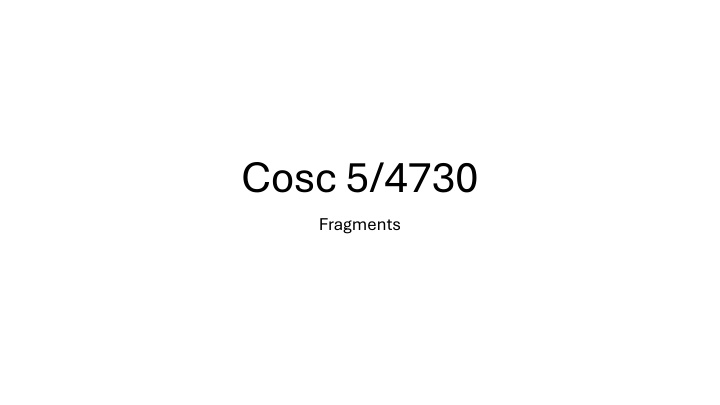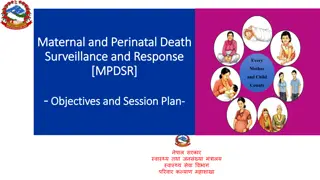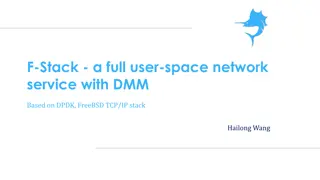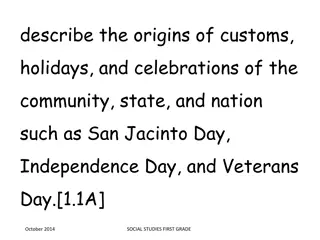
Fragments in Android Development
"Discover the power of fragments in Android app development, allowing for modular sections within activities. Learn how to create, manage, and switch between fragments efficiently. Dive into the basics, layout design, fragment code structure, and more."
Uploaded on | 2 Views
Download Presentation

Please find below an Image/Link to download the presentation.
The content on the website is provided AS IS for your information and personal use only. It may not be sold, licensed, or shared on other websites without obtaining consent from the author. If you encounter any issues during the download, it is possible that the publisher has removed the file from their server.
You are allowed to download the files provided on this website for personal or commercial use, subject to the condition that they are used lawfully. All files are the property of their respective owners.
The content on the website is provided AS IS for your information and personal use only. It may not be sold, licensed, or shared on other websites without obtaining consent from the author.
E N D
Presentation Transcript
Cosc5/4730 Fragments
Fragments You can think of a fragment as a modular section of an activity, which has its own lifecycle, receives its own input events, and which you can add or remove while the activity is running (sort of like a "sub activity" that you can reuse in different activities). There is a Support Library, so your app remains compatible with devices running system versions as old as Android 1.6. You can have more then one fragment in a layout as well. In many ways you can think of a fragment as a custom view. Using the fragment manager, you can easy change between fragments as well. In the xml you use a framelayout, which the fragment is then place in.
Basics The main activity is created as normal with a layout. The code the main activity is reduced to the onCreate, menu, and fragments controls. Otherwise, everything else is handled in the fragments. Fragments come in a couple of varieties like activities Fragment, ListFragment (like a listView), DialogFragment, PreferenceFragment, and WebViewFragment, even a FragmentTabHost
How it works. You will separate code for each fragment (normally in their own file) with their own layout. The Activity will also have it's own code and layout the layout is likely just a framelayout The activity is responsible for changing fragments and communication between fragments.
Activity XML layout In the xml, we using fragment and associate each fragment with a java class of fragment Our example layout: <fragment android:id="@+id/frag_titles" android:layout_weight="1" android:layout_width="0dp" android:layout_height="match_parent" class="edu.cs4730.frag1demo.titlefrag" /> frag_titles uses titlefrag.java class This is the most common layout , since you want to change fragments. This is the most common layout , since you want to change fragments. <framelayout android:id="@+id/container" android:layout_width= match_parent"android:layout_height="match_parent"/> this layout will have one fragment and a framelayout, the LinearLayout of was left off for space.
Fragment code In the Fragment, you have the same callback methods as an activity onCreate(), onStart(), onPause(), and onStop() And OnCreateView() The system calls this when it's time for the fragment to draw its user interface for the first time. To draw a UI for your fragment, you must return a View from this method that is the root of your fragment's layout. You can return null if the fragment does not provide a UI. OnAttach() and OnDetach() This is when a fragment becomes associated with an activity.
Fragment code (2) You should implement at least these three OnCreate(), onCreateView() The onCreate() is for setup of variables OnCreateView() Android also says the OnPause(). See http://developer.android.com/guide/components/fragments.html for the Fragment life cycle and the other callback methods.
Fragment The OnCreateView() returns a view and calls the layout associated with this fragment R.layout.text is the layout being used for this view. @Override public View onCreateView(LayoutInflater inflater, ViewGroup container, Bundle savedInstanceState) { binding = FragmentTwoBinding.inflate(inflater, container, false); binding.tv.setText( Hi ); return binding.getRoot(); } Note this uses viewbinding, which makes fragments much easier to follow. the binding is declared global to the fragment.
Fragments from MainActivity In the activity, using the fragment Manager, you place a fragment in a framelayout the framelayout id is container. If the framelayout is empty, you use add getSupportFragmentManager().beginTransaction() .add(binding.container.getId(), new oneFragment()) .commit(); If you add another, then it appears on top of it showing fragments. Changing from one fragment to another, use replace. getSupportFragmentManager().beginTransaction() .replace(binding.container.getId(), new twoFragment()) .commit(); See the ViewBindingFragDemo in viewbinding directory for demo code.
Communication between fragments we can use callbacks and setters/constructors to communicate between fragments via the activity. The activity passes the data between them or preforms actions the fragments can t (such as changing fragments). Note much of these can be replaced with a modelview and livedata, which android/google is encouraging. And Arch Navigation allows fragments to change between fragments, which really cleans up the code too.
Setters The constructor takes values when the fragment is instantiated. This is done with setArguments/getArguments in the factory methods. A setter takes the new values and updates the variables. The widgets/views are now updates as needed.
callbacks The fragment creates a interface, which is a fragment listener. The activity implements it. This is likely a button click or other action. Now the activity receives it and the data. It then preforms the necessary action. Note, When you create a new fragment, studio has a check mark to create skeleton code for the callback in your fragment.
Callbacks created in the fragment Use the onAttach() and OnDeteach() to set the variable correctly. @Override public void onAttach(Activity activity) { super.onAttach(activity); try { mListener = (OnFragmentInteractionListener) activity; } catch (ClassCastException e) { } } @Override public void onDetach() { super.onDetach(); mListener = null; } Create the interface. public interface OnFragmentInteractionListener { // change parameters to your needs. public void onFragmentInteraction(String Data); } Declare a variable of the interface to use in the fragment. private OnFragmentInteractionListener mListener;
Callbacks fragment in the fragment (2) Lastly use the variable (carefully). if (mListener != null) { mListener.onFragmentInteraction(variable); } Likely called from some widget/view listener when the user preforms some action.
Callbacks used in the activity The activity then implements the interface. public class MainActivity extends ActionBarActivity implements myFrag.OnFragmentInteractionListener { And somewhere in the code @Override public void onFragmentInteraction(String Data) { //matches the one created in fragment //implement whatever code is necessary //to carry out the action. } The activity can implement multiple interfaces for different fragments (different names) or the same one for all of them (same name).
Callbacks, not an Android invention. Android calls them callbacks, but this is just the standard java interface mechanic You can add (and may need) to any class. The method is then just an object that is run when called. Callback/interface vs listener A callback or interface must have an implements X otherwise it won t compile or dies a runtime. There is no default action A listener can work without any extra code and the default action is taken. Normally a default action is to do nothing.
Frag com with listview. Callback listener, via the onItemClick methods the Activity sends the information to the text fragment
Frag com with listview (2) Callback listener, via the onItemClick methods The fragment reads the position via Get arguments, in the onStart() method. It then displays the correct info. Since the text fragment is not on the screen, it adds it and sets the arguments to the fragment. Pressing the back button, return to listview again.
Later on. We will come back and see more of this callbacks in the listview and recyclerview lectures Note, we are going to confuse and simplify this all of this with modelview and architecture navigation.
QA &






















